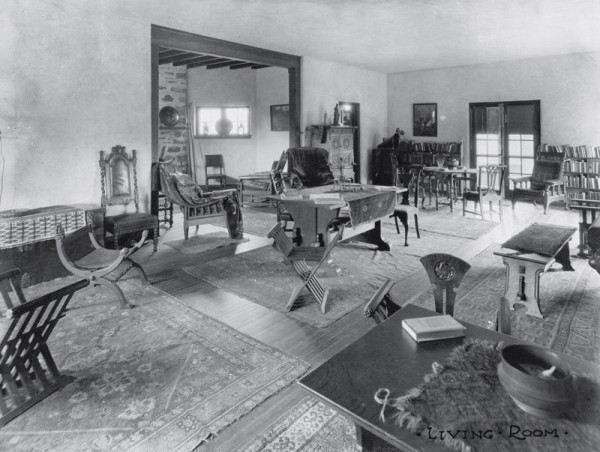
Photograph of the living room of Tower House, Rose Valley, Delaware County, Pennsylvania, ca. 1915. (Courtesy, Athenaeum of Philadelphia.) Tower House was first used as William Lightfoot Price’s studio and was later converted by his son William Webb. It still stands on Price’s Lane in Rose Valley just a few feet from the elder Price’s own house.
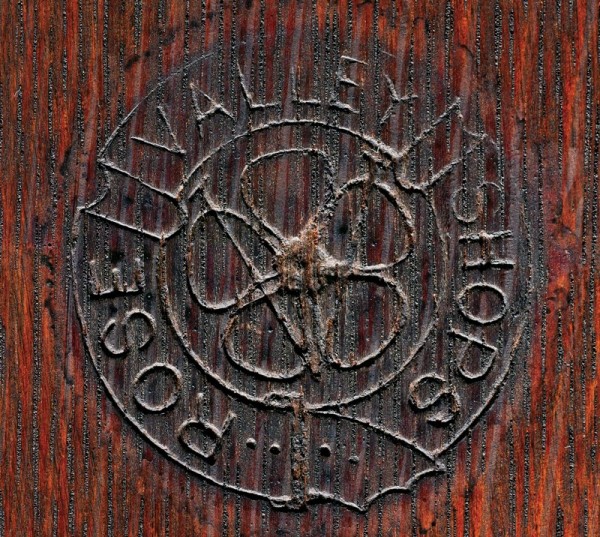
Detail of the Rose Valley brand on the chair illustrated in fig. 30. (Photo, Gavin Ashworth.) Rose Valley was a community of like-minded people but not necessarily a community of craftsmen. Price had intended to franchise the Rose Valley brand to artisans who would come to the community and set up studios and workshops for the production of various crafts like pottery, metalwork, or woodworking. While there was much craft making among the residents, potter William P. Jervis was the only individual authorized to impress the mark on his ceramics. Some surviving furniture made in the Rose Valley Shops bears the brand and some does not; it is not yet known if there was a system of marking that determined which pieces should be branded.

Music stand designed by William Lightfoot Price and made in the woodworking shop at Rose Valley, Delaware County, Pennsylvania, ca. 1905. Woods and dimensions not recorded. (Courtesy, Athenaeum of Philadelphia.) Price designed several music stands, which were produced at Rose Valley and Arden. A variant of this stand was included in a circa 1909 drawing by Rose Valley denizen Alice Barber Stephens and illustrated in Robert Judson Clark, The Arts and Crafts Movement in America, 1876–1916 (Princeton, N.J.: Princeton University Press, 1972), no. 23.
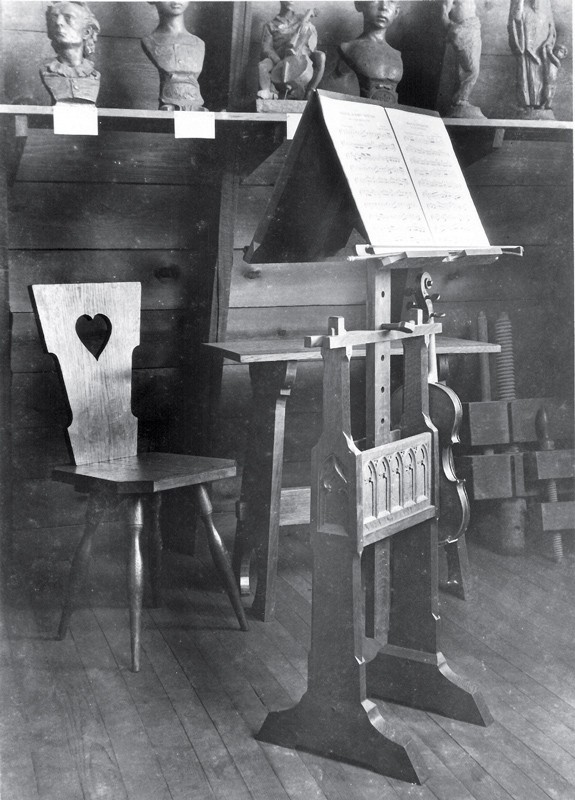
Music stand designed by William Lightfoot Price and made by Don Stephens, Arden, New Castle County, Delaware, ca. 1905. Woods and dimensions not recorded. (Courtesy, Arden Craft Shop Museum and Arden Archives, property of Arden Archives.)
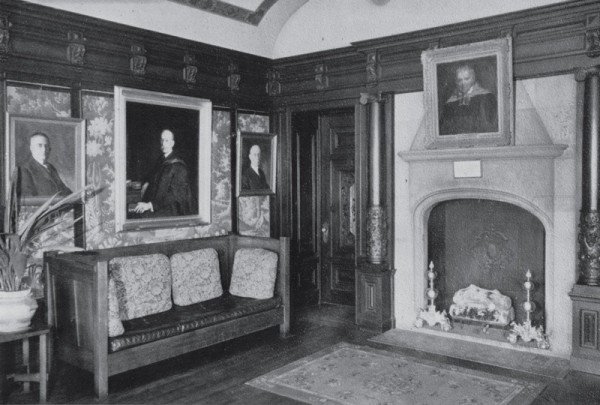
Photograph of a room in Yorklynne, York County, Pennsylvania, ca. 1903. (Courtesy, Lower Merion Historical Society.) Gustav Stickley’s Craftsman furniture factory produced the box settle used in this house, which was designed for John O. Gilmore in 1899. An identical settle is still in use at Glenmede, the house Price designed for George S. Graham in Bryn Mawr, Montgomery County, Pennsylvania, in 1904.
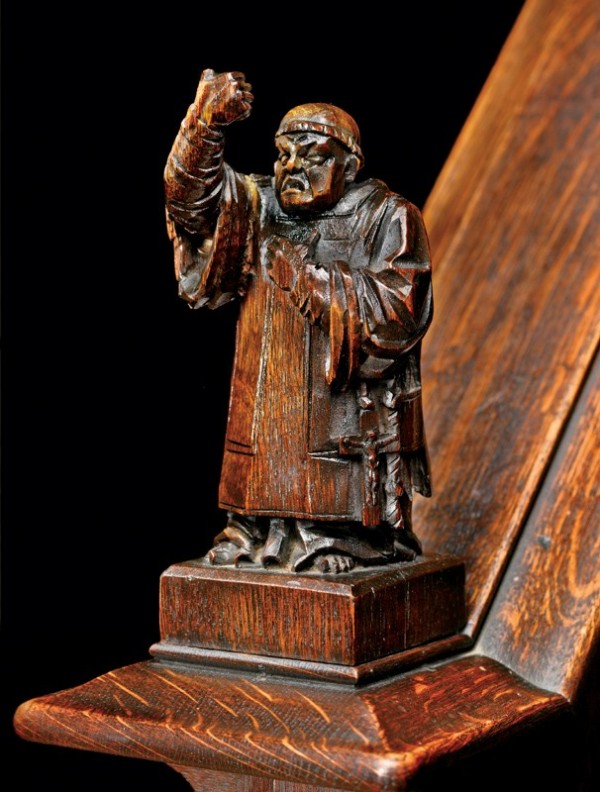
Newel post finial carved by John (Johannnes) Kirchmayer for All Saints Parish Church, Brookline, Massachusetts, 1899–1926. Oak. (Courtesy, All Saints Church; photo, Gavin Ashworth.) Ralph Adams Cram and Bertram Grosvenor Goodhue designed this detail for All Saints Church in 1899. Kirchmayer’s rigid execution is a result of his effort to adhere to the architects’ specifications rather than a nod to Gothic style.
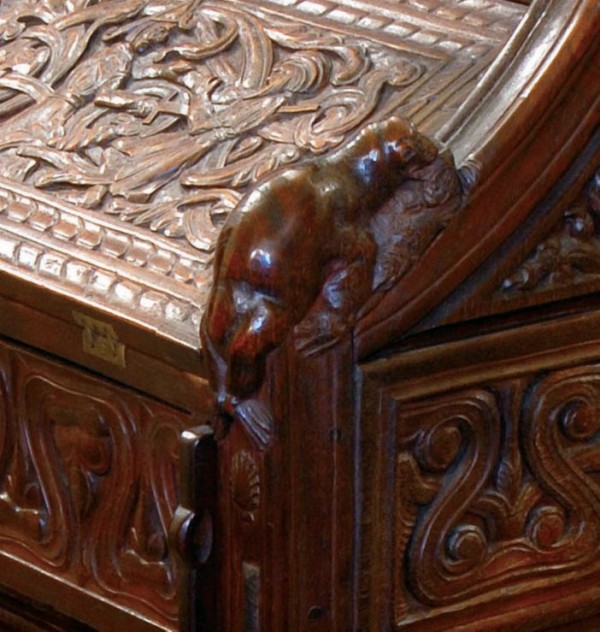
Detail of a walrus carved by Karl von Rydingsvärd for a desk made for Arthur Curtiss James’s yacht Aloha (built in Quincy, Massachusetts, in 1910 and scrapped in 1938). (Collection, Mystic Seaport.) Although von Rydingsvärd sometimes used the traditional Gothic style for carved furniture and woodwork, he favored the voluptuous soft edges and convolutions of the Norse style, inspired by work from his homeland.
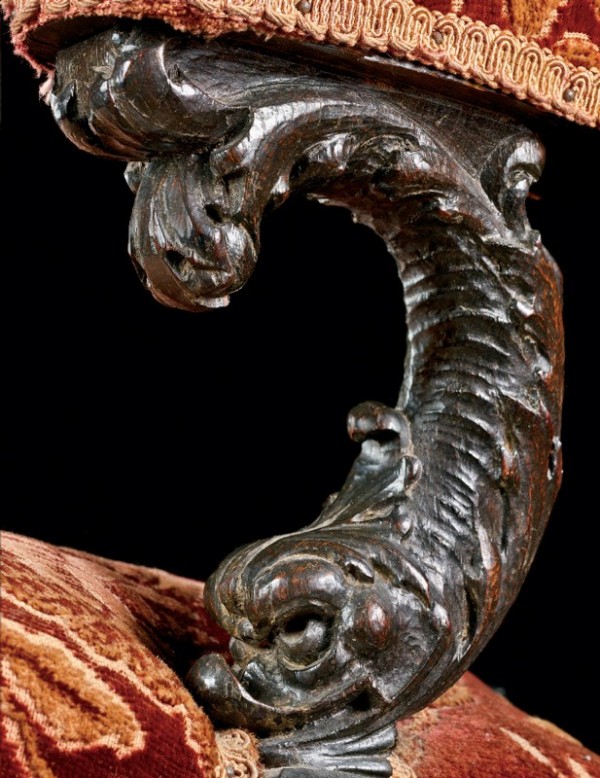
Detail of a dolphin arm support on the chair illustrated in fig. 31. (Private collection; photo, Gavin Ashworth.) Edward Maene carved furniture for his own use or for commissions like the woodwork for the George Washington Memorial Chapel at Valley Forge that was not influenced by Price’s designs. Maene’s carving style is less fluid than that seen on Rose Valley furniture designed by Price.
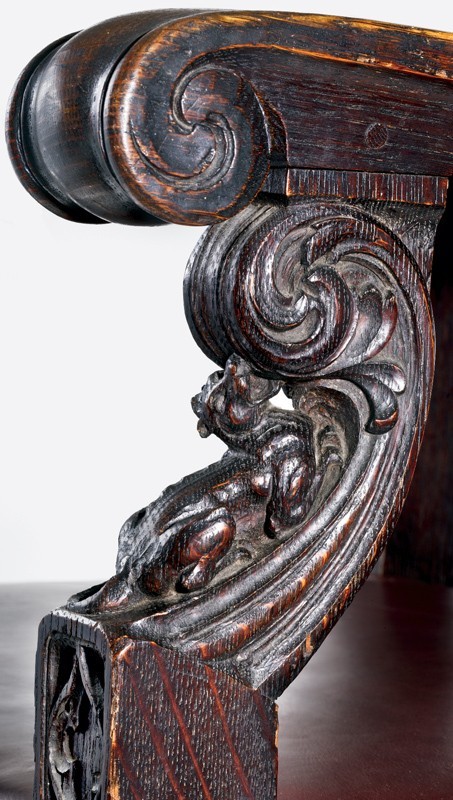
Detail of the arm support of a chair designed by William Price and made in the woodworking shop at Rose Valley, Delaware County, Pennsylvania, or Edward Maene’s shop, 309 Griscom Street, Philadelphia, Pennsylvania, ca. 1903. (Private collection; photo, Gavin Ashworth.) This armchair was made for John O. Gilmore’s house, Yorklynne. The plastic character of carving from the Rose Valley shop may have come from the use of maquettes, often sculpted in clay at Maene’s Philadelphia shop and then copied in wood at Rose Valley.
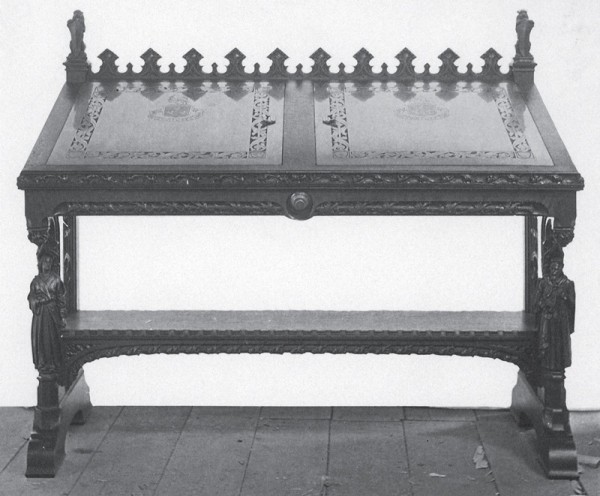
Cabinet designed by William Lightfoot Price and made in Edward Maene’s shop, 309 Griscom Street, Philadelphia, Pennsylvania, ca. 1903. Woods and dimensions not recorded. (Courtesy, Athenaeum of Philadelphia.) In 1903 Horace Trumbauer commissioned a cabinet to display and protect Shakespeare folios owned by William Harrison. The cabinet was completed but never delivered to Harrison. Its whereabouts are not known, but it is hard to believe that such an elaborate and substantial masterpiece is not still extant.
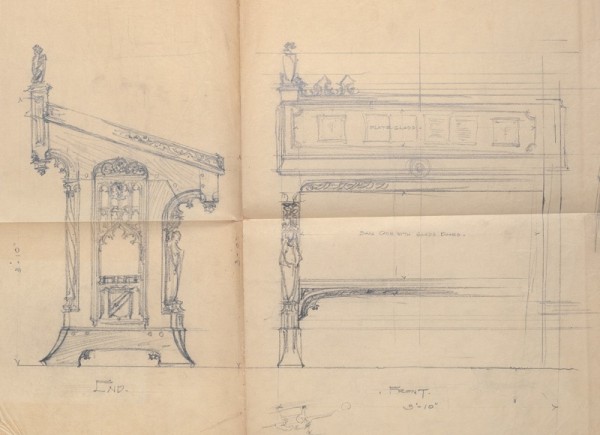
Preliminary drawings for the cabinet illustrated in fig. 10. Graphite on paper. (Courtesy, Philadelphia Museum of Art.) Price made many detailed drawings for the Shakespeare cabinet, which included every carved detail as well as exact specifications for the casting and engraving of the brass panels that were set into the doors on the top of the cabinet.
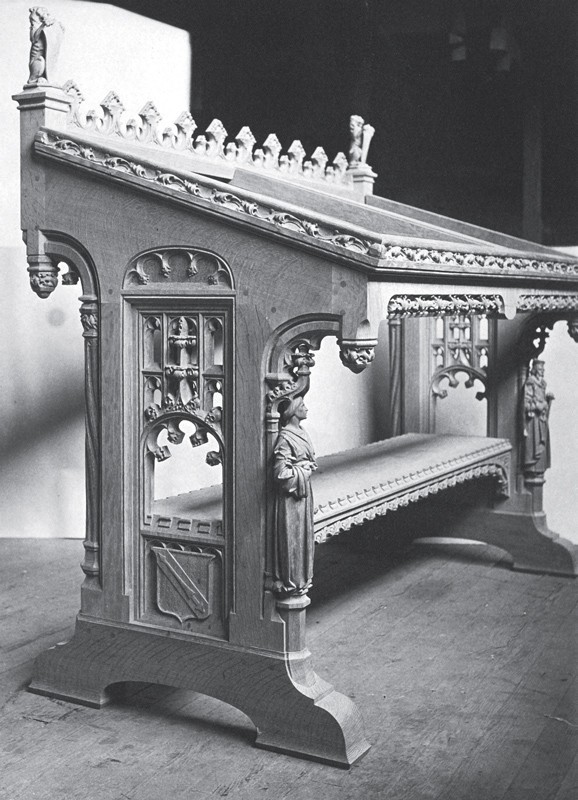
Photograph showing the Shakespeare cabinet in Edward Maene’s shop, 309 Griscom Street, Philadelphia, Pennsylvania, ca. 1903. (Courtesy, Athenaeum of Philadelphia.)
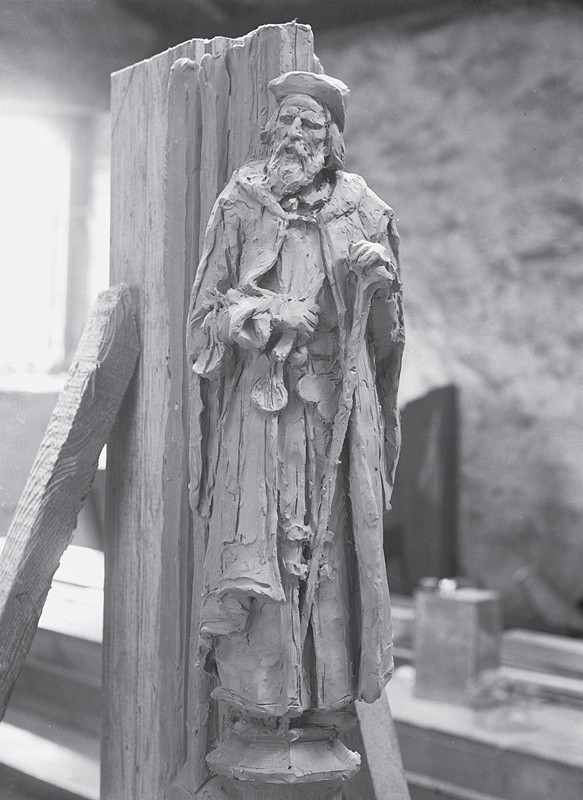
Clay maquette for the Shylock figure on the Shakespeare cabinet in Edward Maene’s shop, 309 Griscom Street, Philadelphia, Pennsylvania, ca. 1903. (Courtesy, Athenaeum of Philadelphia.)
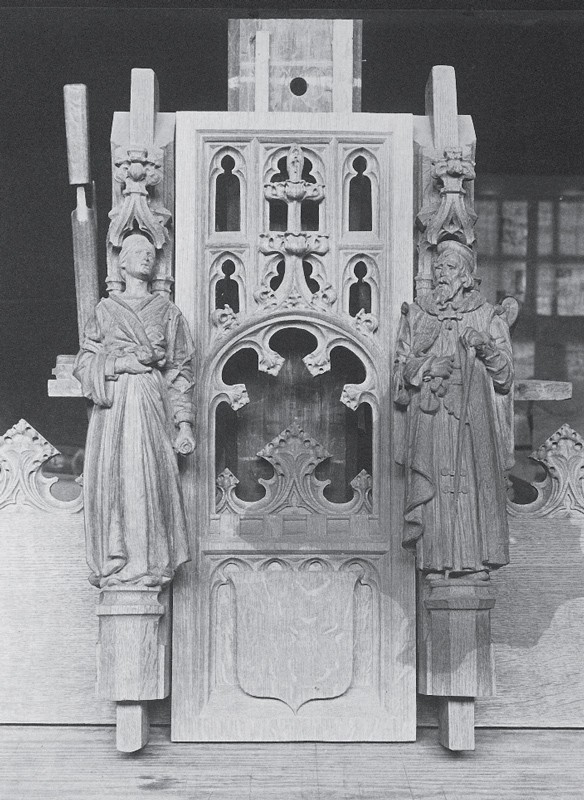
Photograph showing finished components of the Shakespeare cabinet in Edward Maene’s shop, 309 Griscom Street, Philadelphia, Pennsylvania, ca. 1903. (Courtesy, Athenaeum of Philadelphia.) No other Rose Valley piece had such a complete photographic record, which is indicative of how much importance Price accorded this commission.
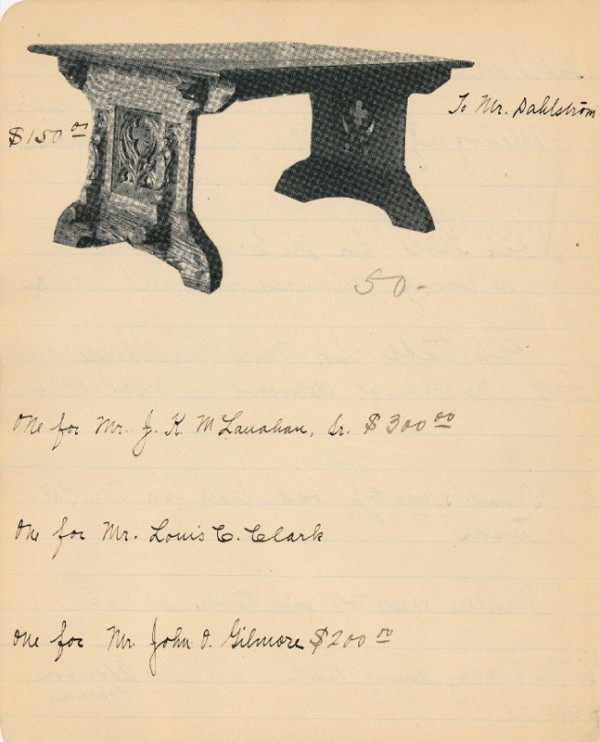
Page from an order book maintained by the Price McLanahan office in Philadelphia, Pennsylvania, 1902–1915. (Courtesy, Athenaeum of Philadelphia.) This page illustrates the table shown in fig. 16 above a list of clients for whom variations of the trestle table form were made. M. Hawley McLanahan (1865–1929) became Price’s partner in the architectural firm that had offices at 1624 Chestnut Street. McLanahan was a real estate developer and office manager.
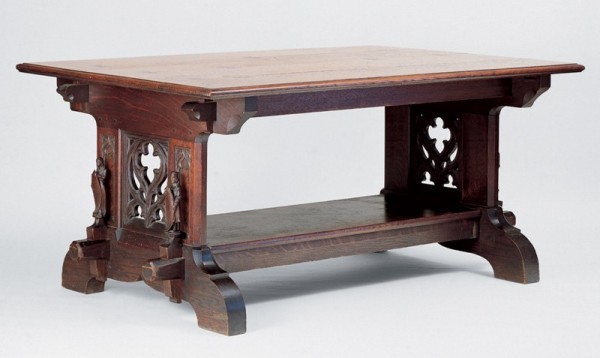
Trestle table designed by William Lightfoot Price and made in the woodworking shop at Rose Valley, Delaware County, Pennsylvania, 1904. White oak. H. 29 1/2", W. 66", D. 39 1/2". (Courtesy, Robert Edwards; photo, Rick Echelmeyer.) This table was made in 1904 for George K. Crozer Jr., but his name does not appear on the order book page illustrated in fig. 15.
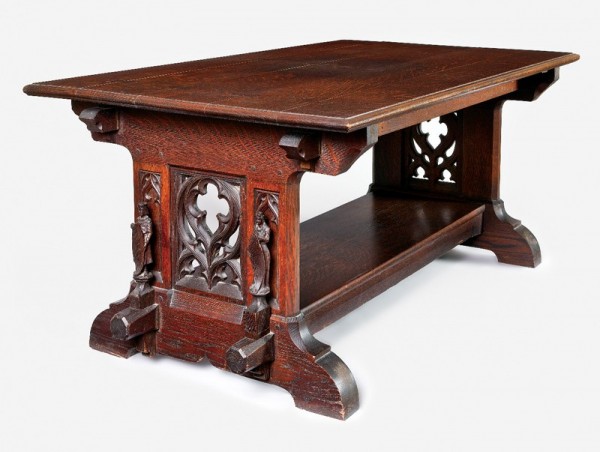
Trestle table designed by William Lightfoot Price and made in the woodworking shop at Rose Valley, Delaware County, Pennsylvania, 1904. White oak. H. 39 1/4", W. 65 3/4", D. 28 1/2". (Private collection; photo, Gavin Ashworth.) This table, which bears the Rose Valley brand, is smaller than the example illustrated in fig. 16 but is otherwise identical.
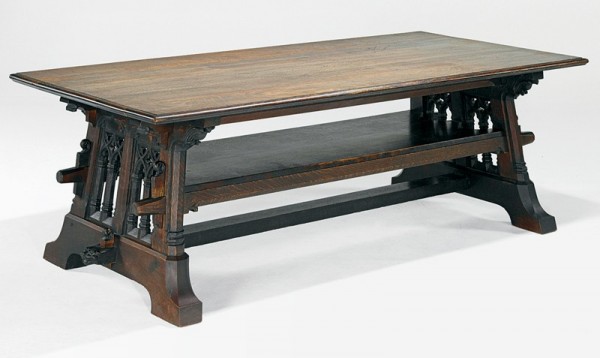
Trestle table designed by William Lightfoot Price and made in the woodworking shop at Rose Valley, Delaware County, Pennsylvania, 1903. White oak. H. 29 1/2", W. 84", D. 40". (Private collection; photo, Rago Arts and Auction Center.) A ca. 1903 photograph of a room in John O. Gilmore’s house, Yorklynne, shows the trestle table along with several Rose Valley chairs. Price sold several tables to Gilmore. The order book listing (see fig. 15) may be for this, the largest example.

Trestle table designed by William Lightfoot Price and likely made in the woodworking shop at Rose Valley, Delaware County, Pennsylvania, or Edward Maene’s shop, 309 Griscom Street, Philadelphia, Pennsylvania, ca. 1904. Price and McLanahan designed the J. K. McLanahan Sr. house in Hollidaysburg, Pennsylvania, where two Rose Valley tables were photographed. The larger table shown here, which may be the one listed in the order book, is now lost.
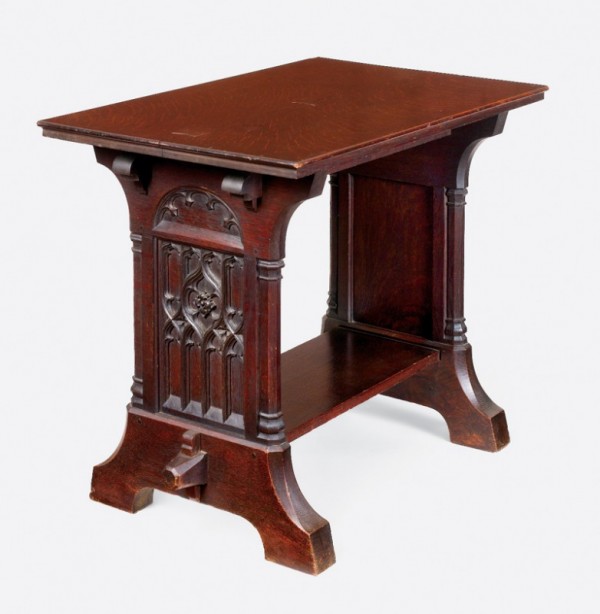
Trestle table designed by William Lightfoot Price and made in the woodworking shop at Rose Valley, Delaware County, Pennsylvania, ca. 1903. White oak. H. 29 3/4", W. 36", D. 23 1/2". (Author’s collection; photo, Gavin Ashworth.) This table bears the Rose Valley brand.
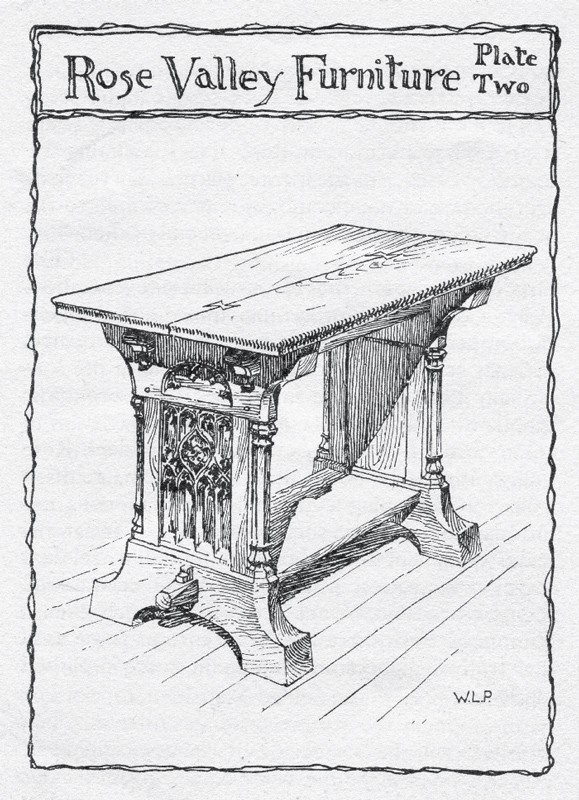
Drawing of the table illustrated in fig. 20. (Artsman 1, no. 1 [October 1903]: 12.)
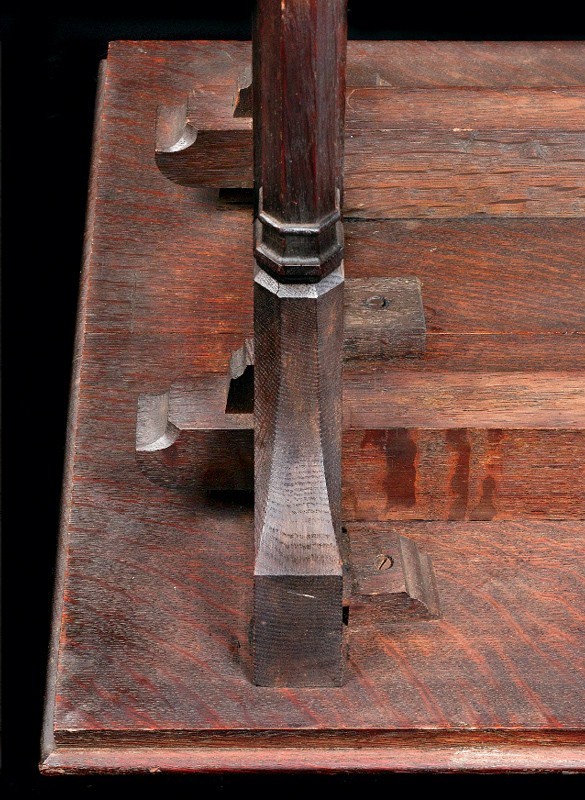
Detail of the top and frame construction of the table illustrated in fig. 20. (Photo, Gavin Ashworth.) Price always used functional joinery to construct the furniture he designed, which is an identifying feature now used to distinguish unsigned Rose Valley furniture from contemporaneous production.

Photograph of the interior of the woodworking shop at Rose Valley, Delaware County, Pennsylvania, ca. 1903. (Courtesy, Athenaeum of Philadelphia.)
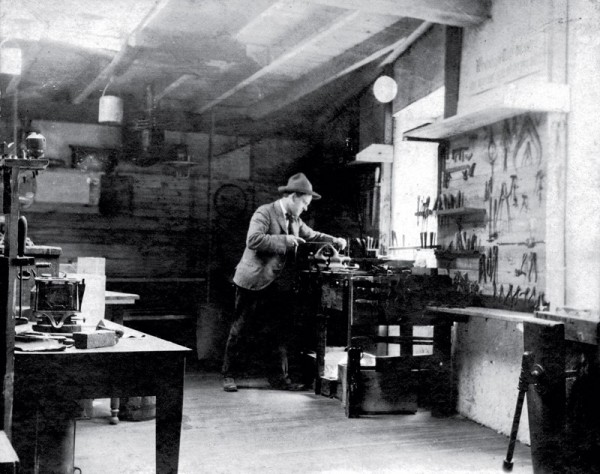
Photograph of Henry Hetzel in his workshop, Rose Valley, Delaware County, Pennsylvania, ca. 1904. (Courtesy, Winterthur Library, Joseph Downs Collection of Manuscripts and Printed Ephemera.)
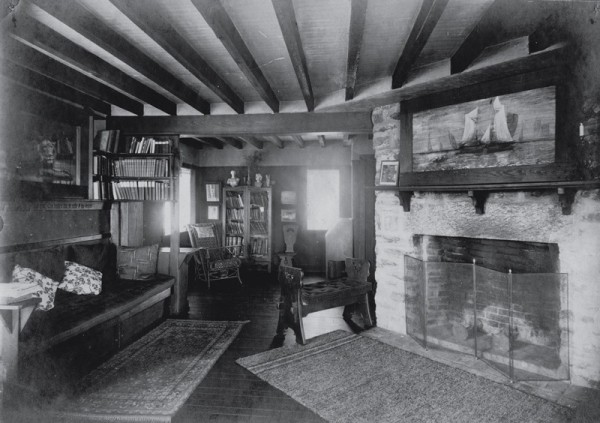
Photograph showing the living room of the House of the Democrat, Rose Valley, Delaware County, Pennsylvania, 1906. (Durando Nichols, “The Model Home: Some Successful Small Houses Costing from $1,200 to $2,400,” American Homes and Gardens 2, no. 1 [March 1906]: 161–65.) Hetzel made much of the furniture visible in this photo, including the bench illustrated in fig. 27.

“Rose Valley Gothic Bench: Designed, Drawn and Built by Henry Hetzel,” Artsman 2, no. 11 (August 1905): 352.
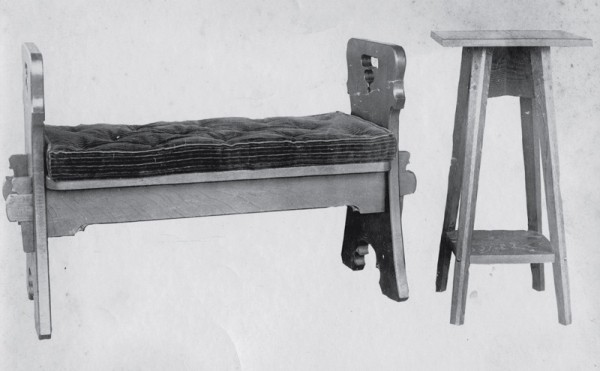
Photograph of the bench made by Henry Hetzel (fig. 28) next to a stand that appears to be his copy of a commercially produced example, ca. 1905. (Courtesy, Winterthur Library, Joseph Downs Collection of Manuscripts and Printed Ephemera.)
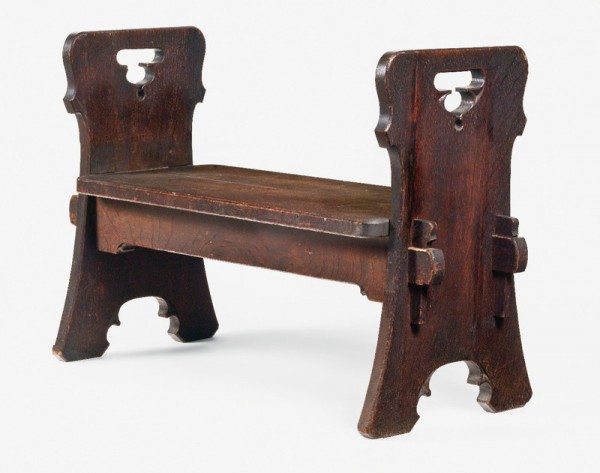
Bench made by Henry Hetzel at his woodworking shop at Rose Valley, Delaware County, Pennsylvania, ca. 1903. White oak, H. 27", W. 37 1/2", D. 17 1/4". (Private collection; photo, Gavin Ashworth.)
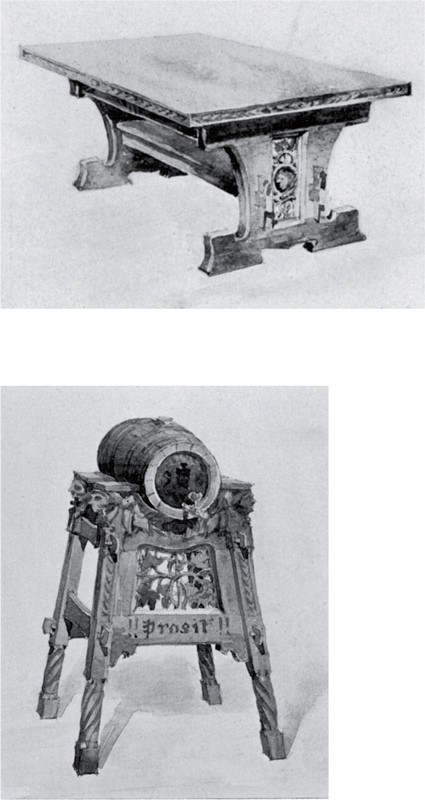
Furniture designs by John Bissegger, Catalogue of the Annual Architectural Exhibition (Philadelphia: T Square Club, 1899–1900), p. 52.

Armchair designed by William Lightfoot Price and made in the woodworking shop at Rose Valley, Delaware County, Pennsylvania, ca. 1903. White oak. H. 45 1/4", W. 25 1/4", D. 25 3/4". (Private collection; photo, Gavin Ashworth.) This chair bears the Rose Valley brand. An identical chair with a leather seat appeared in a line-cut illustration in Artsman 1, no. 1 (October 1903): 4.
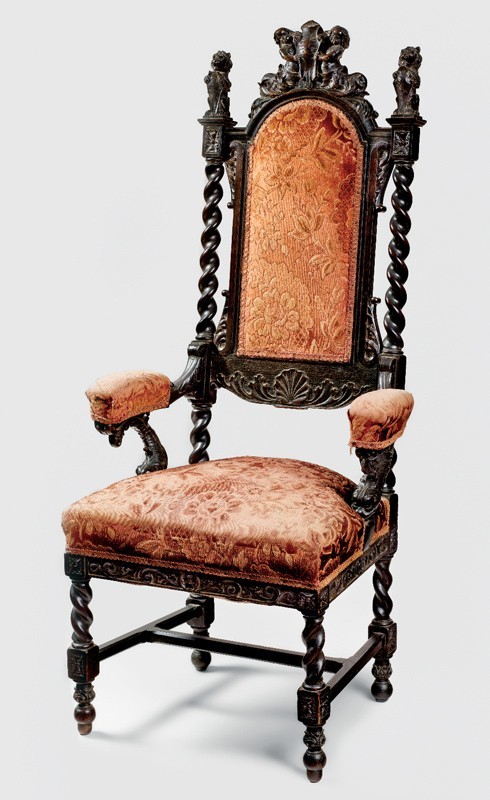
Armchair attributed to Edward Maene’s shop, 309 Griscom Street, Philadelphia, Pennsylvania, ca. 1895. White oak. H. 51 1/2", W. 21 1/2", D. 18". (Private collection; photo, Gavin Ashworth.)
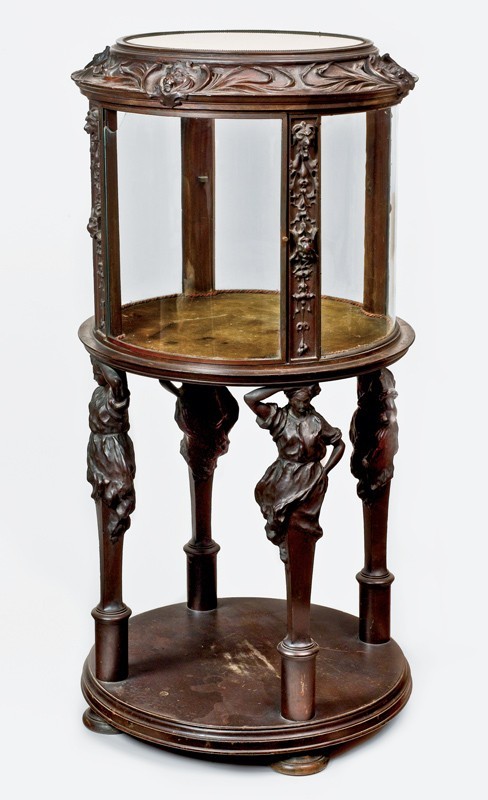
Vitrine designed and made in Edward Maene’s shop, 309 Griscom Street, Philadelphia, Pennsylvania, ca. 1900. White oak; glass. H. 46", Diam. 21 3/4". (Private collection; photo, Gavin Ashworth.) Price would never have designed such a fanciful piece of furniture as this round vitrine supported on three caryatids, whose form and costume are an art nouveau interpretation of a classical convention.
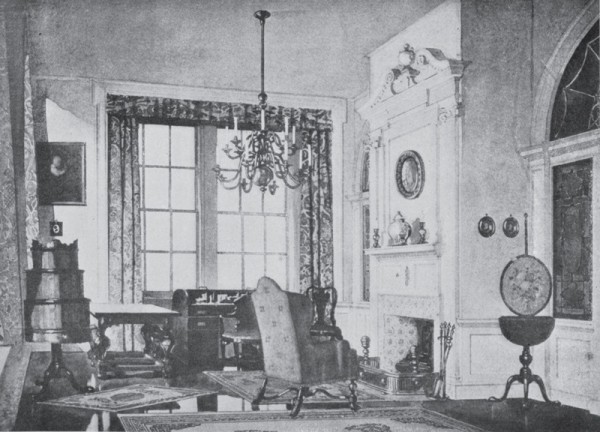
Illustration from a Tiffany Studios advertisement, House Beautiful 29, no. 5 (April 1911): XLIII.
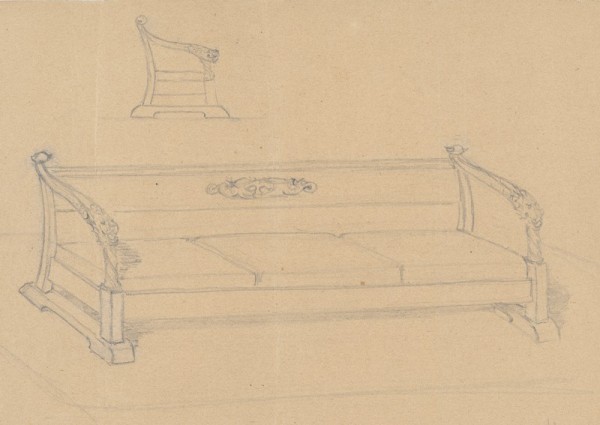
William Lightfoot Price, design for a couch, Rose Valley, Delaware County, Pennsylvania, ca. 1904. Graphite on paper. (Courtesy, Philadelphia Museum of Art.)
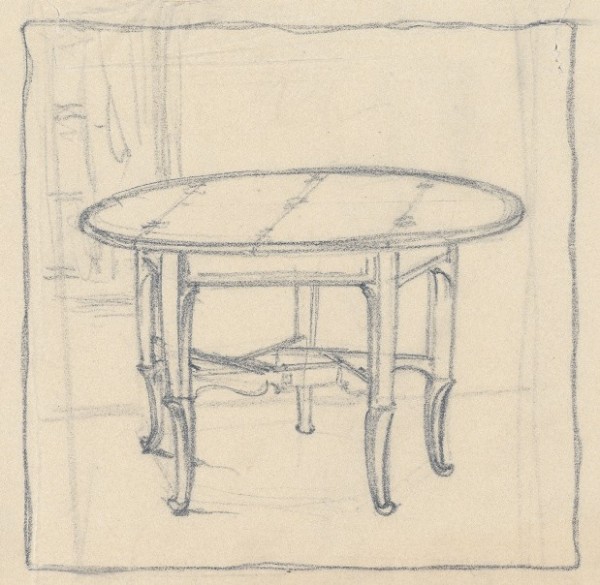
William Lightfoot Price, design for a gateleg table, Rose Valley, Delaware County, Pennsylvania, ca. 1905. Graphite on paper. (Courtesy, Philadelphia Museum of Art.) A circa 1905 photograph now at the Athenaeum of Philadelphia documents that the Rose Valley shop made a mahogany table of this type for W. F. Davidson. This style would have been called Queen Anne.
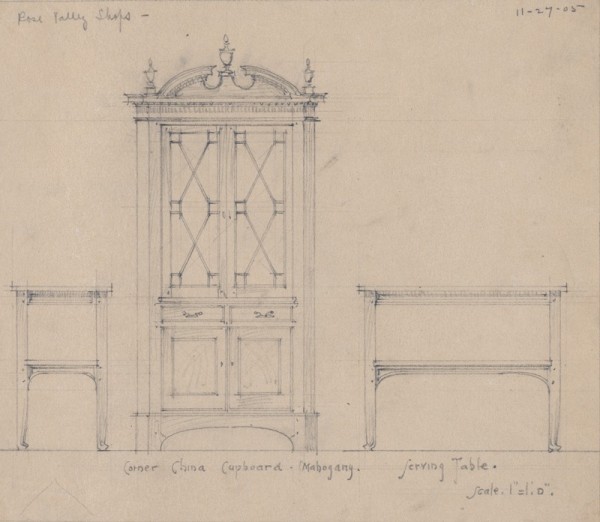
William Lightfoot Price, design for a “corner china cupboard and serving table,” Rose Valley, Delaware County, Pennsylvania, 1905. Graphite on paper. (Courtesy, Philadelphia Museum of Art.)
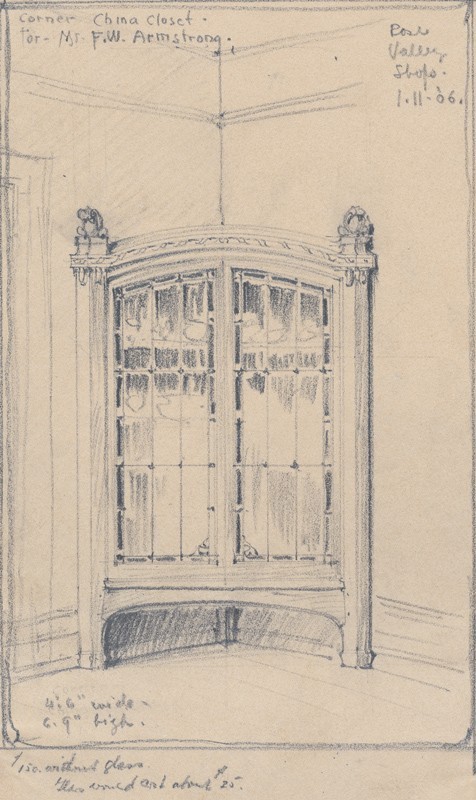
William Lightfoot Price, design for a “Corner China Closet for Mr. F. W. Armstrong,” Rose Valley, Delaware County, Pennsylvania, 1906. Graphite on paper. (Courtesy, Philadelphia Museum of Art.) In this design, a Georgian furniture form has been embellished with Gothic details.
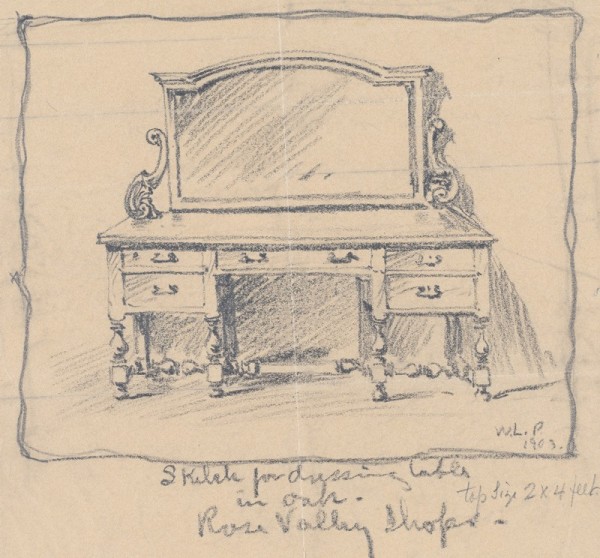
William Lightfoot Price, “Sketch for Dressing Table in Oak,” Rose Valley, Delaware County, Pennsylvania, 1903. Graphite on paper. (Courtesy, Philadelphia Museum of Art.) Although Price was well versed in antique furniture styles and often labeled his designs as “Gothic” or “Jacobean,” he was never pedantic in his interpretations. Modern forms like this dressing table required an eclectic mix of elements.
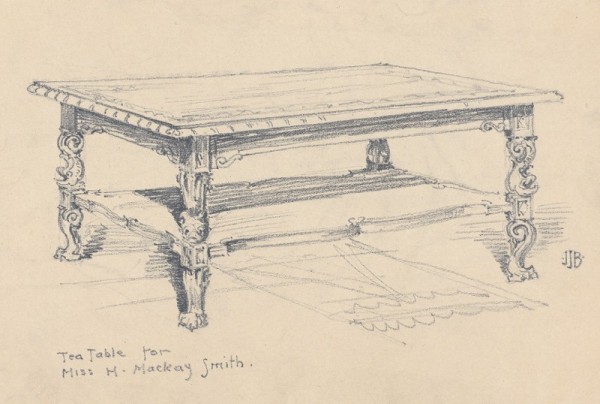
John Bissegger, design for a “Tea Table for Miss H. Mackay-Smith,” Rose Valley, Delaware County, Pennsylvania, 1905. Graphite on paper. (Courtesy, Philadelphia Museum of Art.) The Mackay-Smith commission included some of the most elaborate and stylistically eccentric designs ever devised at the Rose Valley shop. Bissegger made this drawing on paper with a Rose Valley letterhead. Dolphin carvings are not typical of work from Rose Valley, but they do appear on furniture designed and made by Edward Maene (figs. 8, 31).
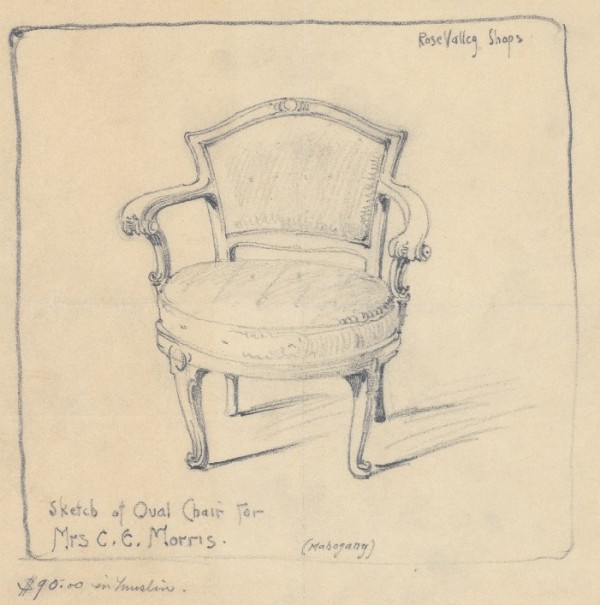
William Lightfoot Price, “Sketch of Oval Chair for Mrs. C. E. Morris,” Rose Valley, Delaware County, Pennsylvania, ca. 1905. Graphite on paper. (Courtesy, Philadelphia Museum of Art.) In this design Price accommodated his client’s desire for a relatively tepid interpretation of the rococo-revival style.
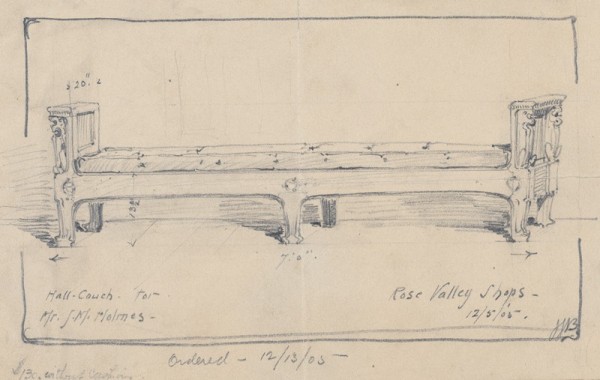
William Lightfoot Price, design for a “Hall Couch for Mr. Jos. Holmes,” Rose Valley, Delaware County, Pennsylvania, December 5, 1905. Graphite on paper. (Courtesy, Philadelphia Museum of Art.)
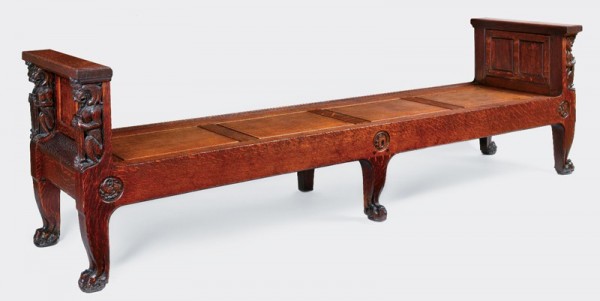
Hall couch designed by William Lightfoot Price and made in the woodworking shop at Rose Valley, Delaware County, Pennsylvania, or Edward Maene’s shop, 309 Griscom Street, Philadelphia, Pennsylvania, 1905. White oak. H. 25 3/4", W. 84 1/2", D. 21 1/2". (Private collection; photo, Gavin Ashworth.) An inscription on the drawing (fig. 41) indicates that Holmes ordered this couch on December 13, 1905. This piece, which bears the Rose Valley brand, differs from Price’s drawing in having heraldic lions rather than eagles.
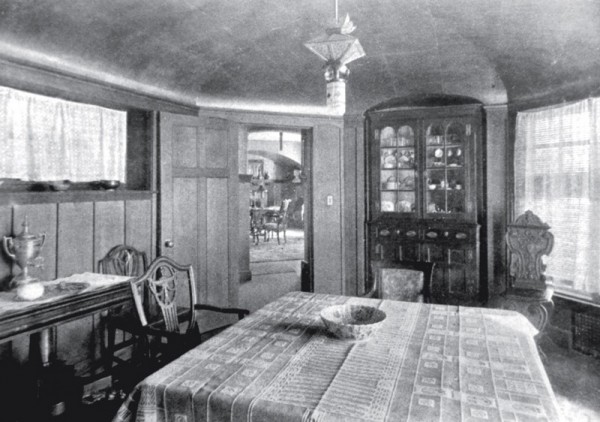
Photograph of the dining room in Thunderbird Lodge, Rose Valley, Pennsylvania. (Ralph de Martin, “Homes of American Artists: An Artist’s Home in Rose Valley,” American Homes and Gardens 6, no. 3 [March 1909]: 98.) Price designed the house and studios to enshrine Frank Stephens’s important collection of Native American artifacts and his wife Alice’s collection of American antiques.
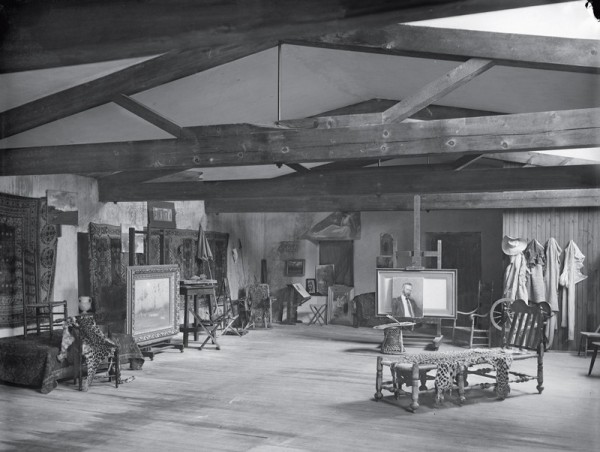
Photograph of artist Francis Day’s studio above Folk Hall, Rose Valley, Delaware County, Pennsylvania, ca. 1905. (Courtesy, Athenaeum of Philadelphia.) Day’s portrait of William Lightfoot Price is on the easel near the center of the room.
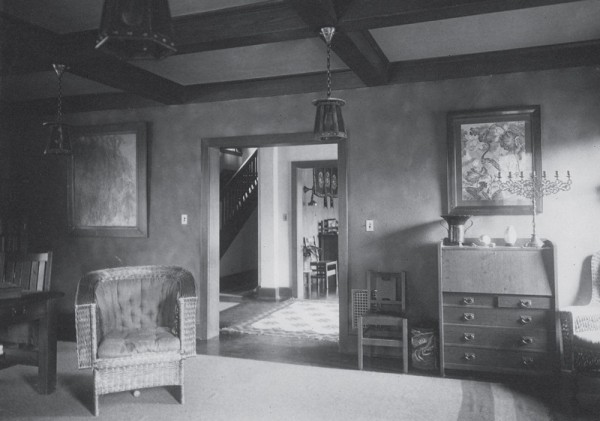
Photograph of the living room in the George G. Greene house, designed in 1911 by William Lightfoot Price and Martin Hawley McLanahan, Woodbury, New Jersey, ca. 1912. (Courtesy, Athenaeum of Philadelphia.) It is not known whether Price or Greene ordered the Stickley furnishings.
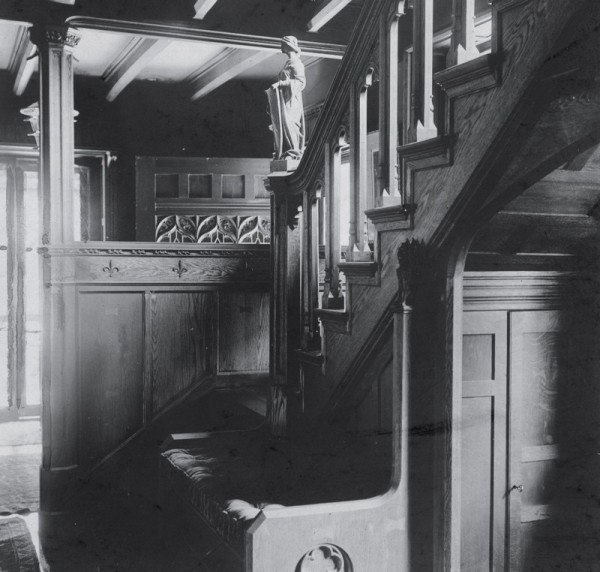
Photograph of the stairway in the John Clarke house, Bryn Mawr, Montgomery County, Pennsylvania, ca. 1897. (Courtesy, Athenaeum of Philadelphia.) William Lightfoot Price altered a Frank Furness design in 1896.
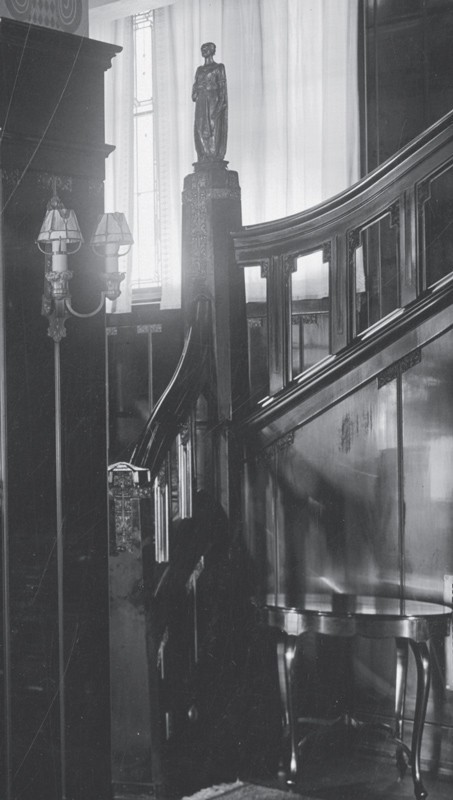
Photograph of the main stairway of the Frank H. Wheeler house, designed in 1911 by William Lightfoot Price, ca. 1914. (Courtesy, Drawings and Documents Archive, Ball State University, Muncie, Indiana.) The style of the carving in the Wheeler house is more modern than that in the 1896 Clarke house (fig. 46), but certain elements, like the figures on the newel posts, remained essentially unchanged.
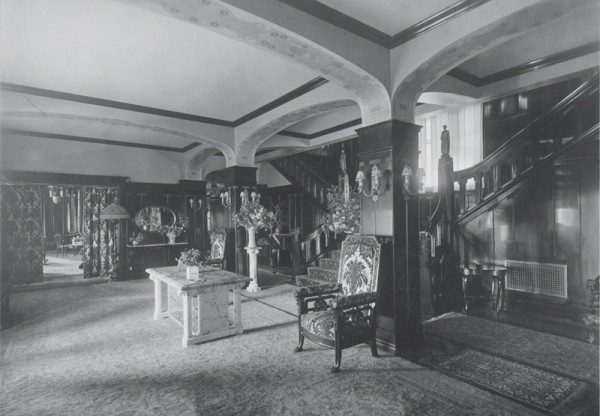
Photograph of the main hall of the Frank H. Wheeler house, designed in 1911 by William Lightfoot Price, ca. 1914. (Courtesy, Drawings and Documents Archive, Ball State University, Muncie, Indiana.) Price probably designed the marble center table, but the rest of the furnishings came from Tobey Furniture Company.
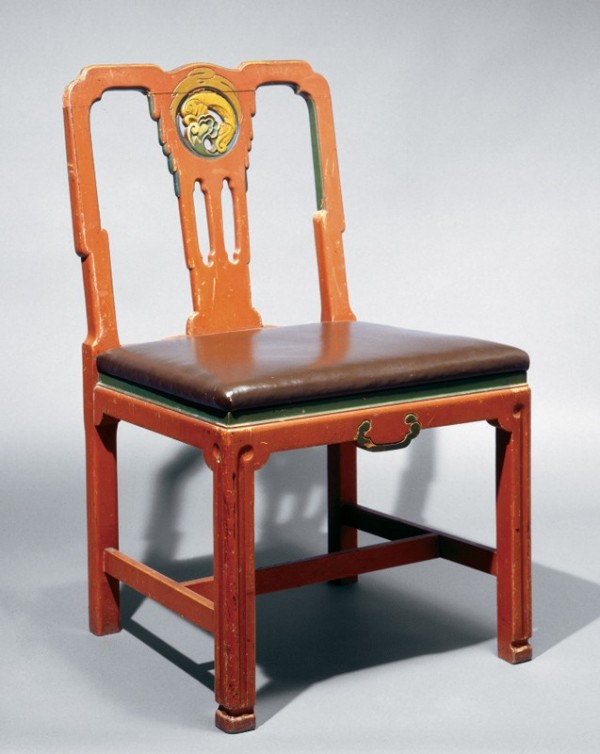
Chair specified by William Lightfoot Price for a dining room in the Traymore Hotel, Atlantic City, New Jersey, ca. 1915. Woods and dimensions not recorded. (Courtesy, Julie Marquart for Venturi, Scott Brown and Associates, Inc.) Price probably subcontracted the Traymore polychrome furniture and the Wheeler dining chairs to a factory like Tobey Furniture Company.
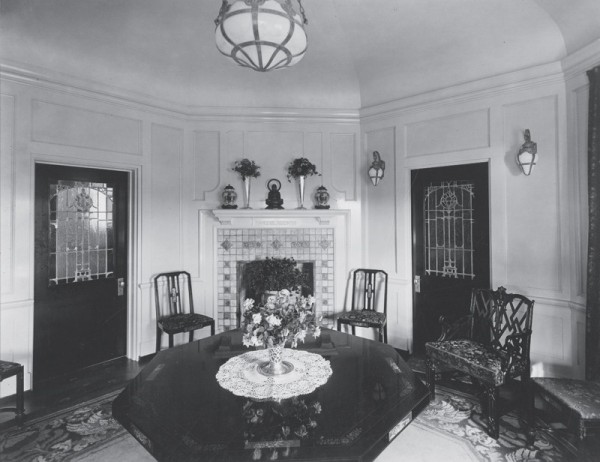
Photograph of the dining room in the Frank H. Wheeler house, designed in 1911 by William Lightfoot Price, ca. 1914. (Courtesy, Drawings and Documents Archive, Ball State University, Muncie, Indiana.)
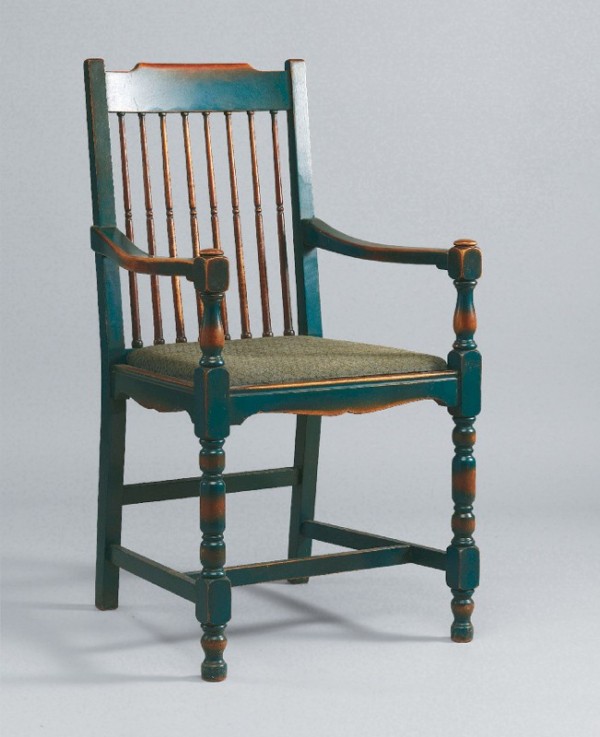
Chromewald dining chair designed by Gustav Stickley and made at the Craftsman Workshops, Eastwood, New York, ca. 1915. Woods and dimensions not recorded. (Private collection; photo, Thomas Gleason.) Stickley’s polychrome furniture is less modern than Price’s contemporaneous painted designs.
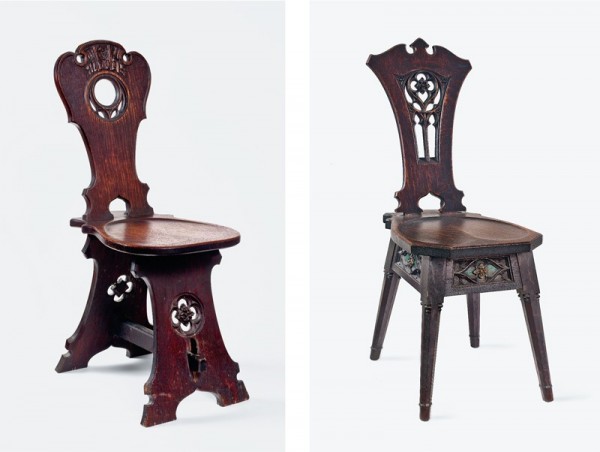
Pair of chairs designed by William Lightfoot Price and made in the woodworking shop at Rose Valley, Delaware County, Pennsylvania, or Edward Maene’s shop, 309 Griscom Street, Philadelphia, Pennsylvania, ca. 1904. Oak. H. 36 1/4", W. 14", D. 18 5/8" (left); H. 37", W. 14 5/8", D. 19 5/8" (right). (Private collection; photo, Gavin Ashworth.) Evidence suggests that Price sold chairs of different designs as a pair. This pair descended in the family of his brother Walter.
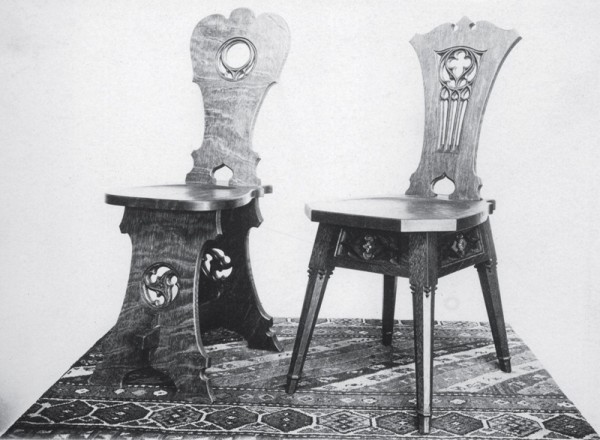
Pair of chairs designed by William Lightfoot Price and made in the woodworking shop at Rose Valley, Delaware County, Pennsylvania, or Edward Maene’s shop, 309 Griscom Street, Philadelphia, Pennsylvania, ca. 1904. White oak. Dimensions not recorded. (Courtesy, Athenaeum of Philadelphia.)
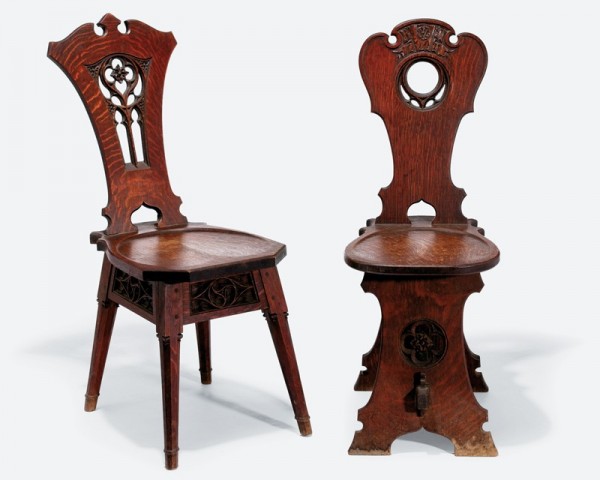
Pair of chairs designed by William Lightfoot Price and made in the woodworking shop at Rose Valley, Delaware County, Pennsylvania, or Edward Maene’s shop, 309 Griscom Street, Philadelphia, Pennsylvania, ca. 1904. White oak. H. 37", W. 14 5/8", D. 19 5/8". (Courtesy, Freeman's; photo, Elizabeth Field.)
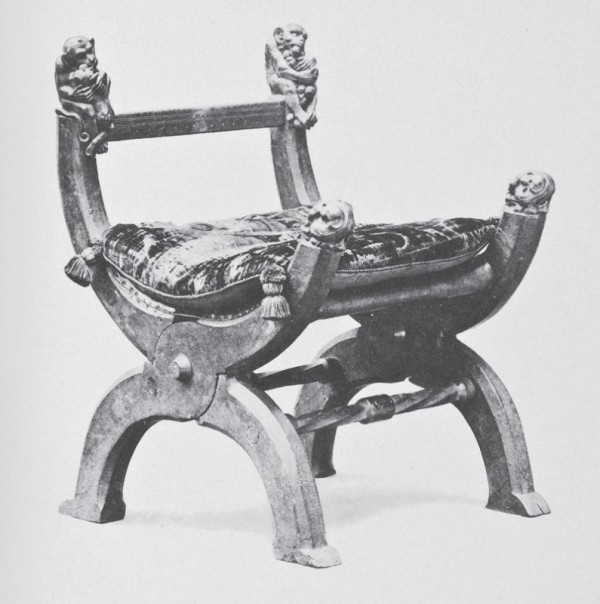
Faltstuhl, Tirol region of Austria, late fifteenth or early sixteenth century. (Jacob von Falke, Mittelalterliches Holzmobiliar, 2nd ed. [1894; Vienna: Schroll, 1897], pl. 7.) (Courtesy, Winterthur Library, Printed Book and Periodical Collection.) This chair inspired the work of several early twentieth-century furniture makers, including William Lightfoot Price.
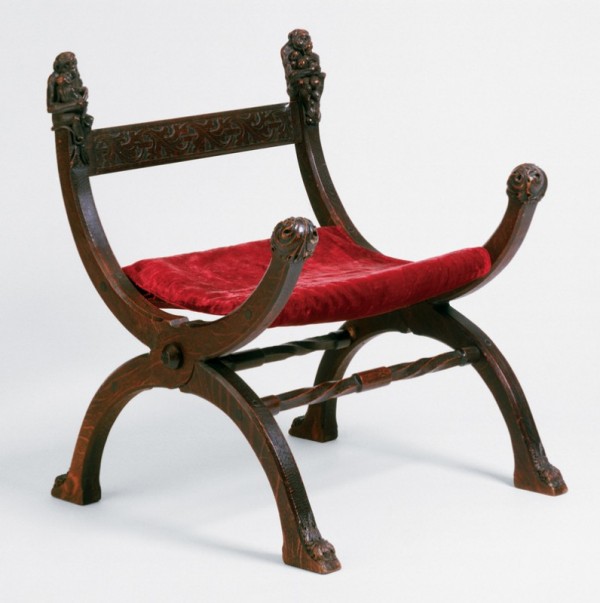
Folding chair designed by William Lightfoot Price and made in the woodworking shop at Rose Valley, Delaware County, Pennsylvania, or Edward Maene’s shop, 309 Griscom Street, Philadelphia, Pennsylvania, ca. 1903. White oak. H. 29", W. 23 1/2", D. 24 3/4". (Courtesy, Philadelphia Museum of Art.) The upholstery is replaced. An identical chair descended in the J. K. McLanahan family, and the Philadelphia Museum of Art has a drawing of another designed for the Mackay-Smith family.
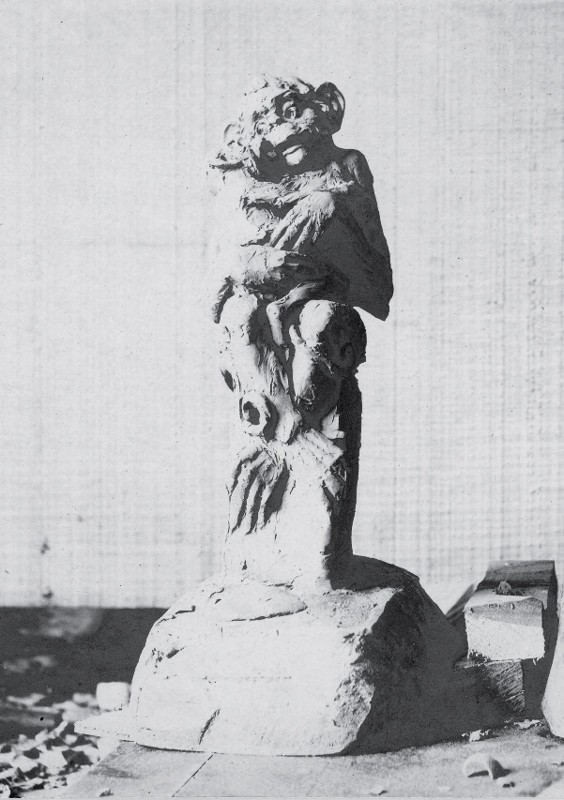
Photograph of a clay model from which the finial on the chair illustrated in fig. 56 was carved, probably in Edward Maene’s shop, 309 Griscom Street, Philadelphia, Pennsylvania, ca. 1903. (Courtesy, Athenaeum of Philadelphia.)
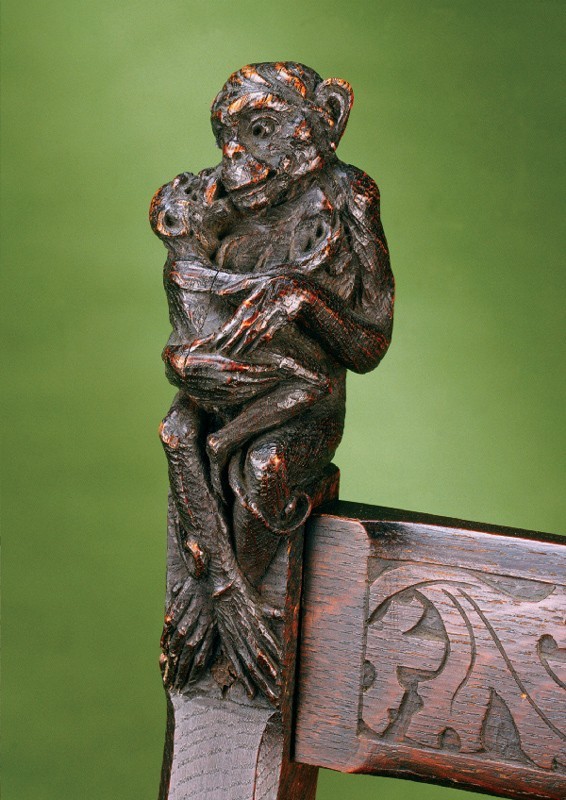
Detail of the finial of the chair illustrated in fig. 56.
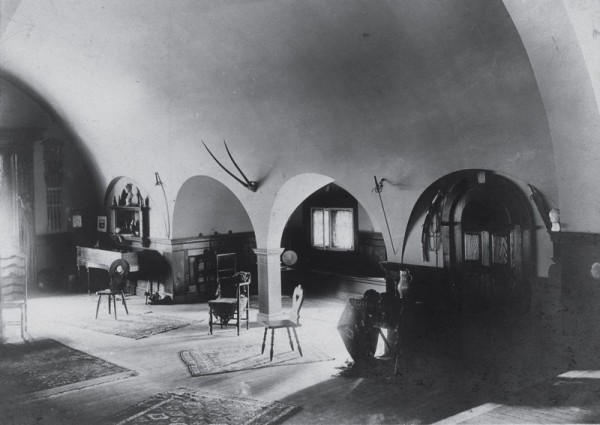
Photograph of the attic of William Lightfoot Price’s house, Kelty, Lower Merion, Pennsylvania, ca. 1902. (Courtesy, Athenaeum of Philadelphia.) Price’s house was built in 1895 and had an attic in the ratskeller style. Chairs identical to those Don Stephens built for the dining room of his house in Arden, Delaware (see fig. 63), are in the center. Given Price’s fascination with American antiques, he might well have been aware of similar chairs made by colonists of northern European descent in southeastern Pennsylvania. It is also possible that he saw published illustrations of brettstuhls.
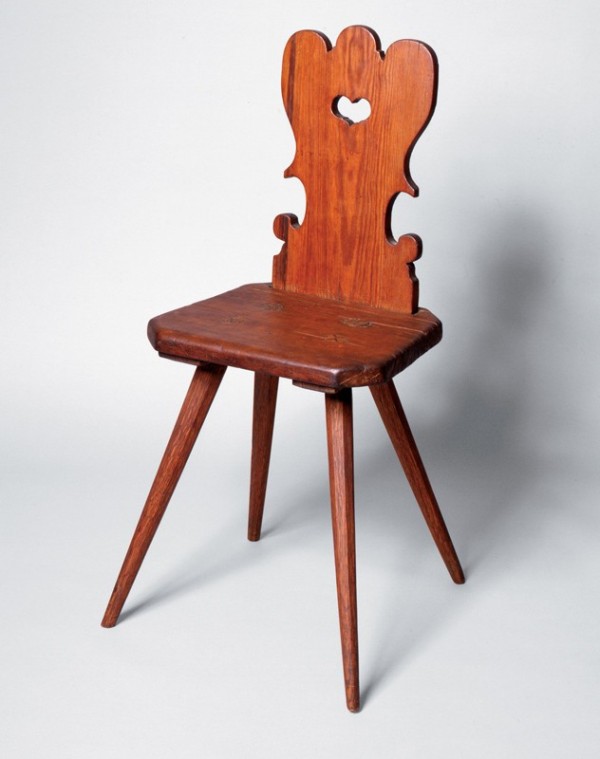
Brettstuhl, southeastern Pennsylvania, 1740–1770. White oak and yellow pine. Dimensions not recorded. (Private collection; photo, Philip Bradley Antiques.)
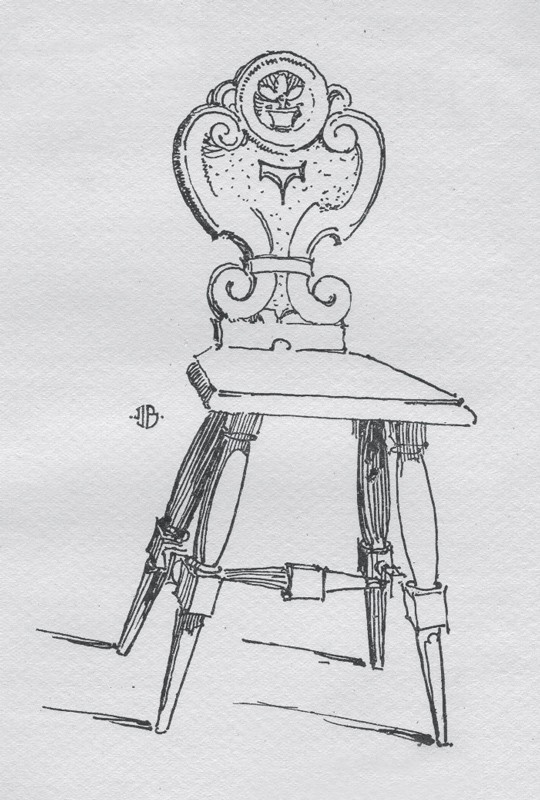
John Bissegger, drawing of “A Rose Valley Hall Chair,” Artsman 2, no. 6 (March 1905): 192.
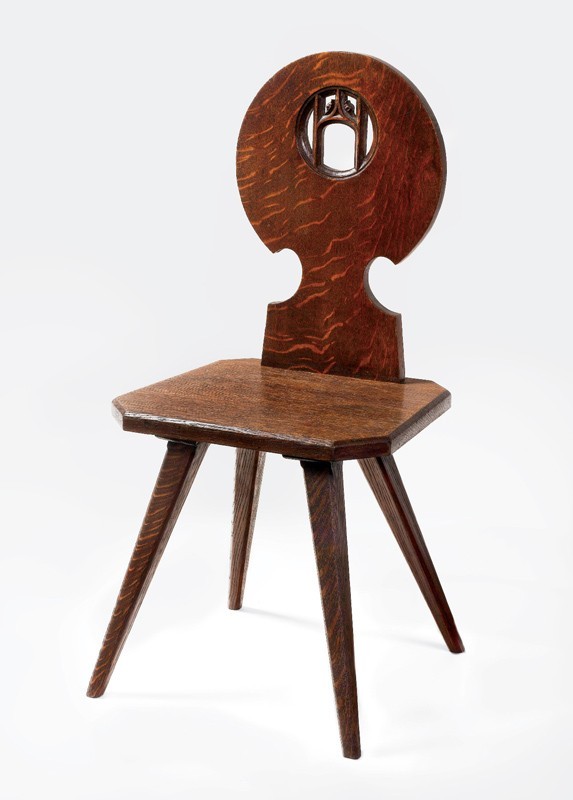
Chair designed by William Lightfoot Price and made by Don Stephens, Arden, Delaware, ca. 1915. White oak. H. 35 1/2", W. 16", D. 16". (Author’s collection; photo, Gavin Ashworth.)

Photograph of the dining room in Don Stephens’s house, Bide-a-wee, Arden, Delaware, ca. 1916. (Courtesy, Arden Craft Shop Museum.) A chair identical to that illustrated in fig. 62 is at the right end of the dining table.
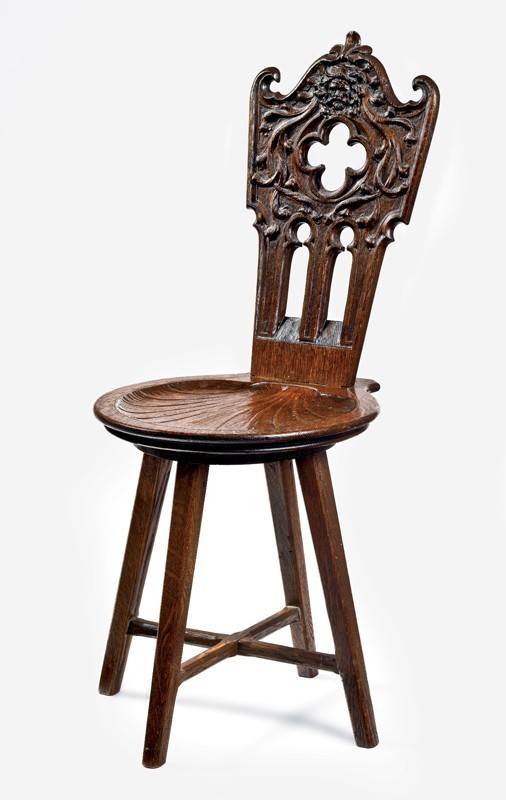
Hall chair attributed to Edward Maene’s shop, 309 Griscom Street, Philadelphia, Pennsylvania, ca. 1900. White oak. H. 37", W. 15 3/4", D. 18 1/4". (Private collection; photo, Gavin Ashworth.)
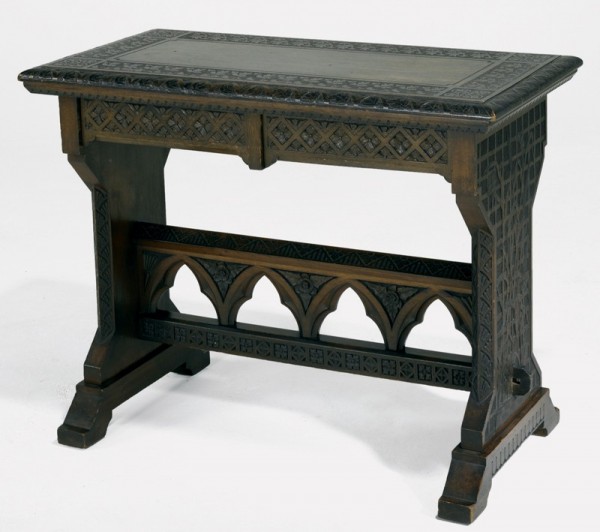
Anna Jordan, desk, Cincinnati, Ohio. Walnut. H. 30", W. 38", D. 19". (Courtesy, Rago Arts and Auction Center.) In general, students at the Cincinnati carving school run by Benn Pitmann and William and Henry Fry did not make the furniture they carved, which resulted in complex surface decorations that spread over the wood surfaces like a slipcover. Price’s carving designs were intended to be integral to the structure as on the Rose Valley table illustrated in fig. 66; he did not use carving as mere surface decoration.
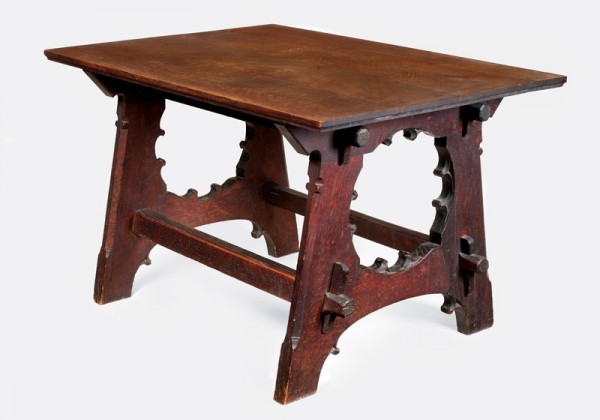
Trestle table designed by William Lightfoot Price and made in the woodworking shop at Rose Valley, Delaware County, Pennsylvania, ca. 1903. White oak. H. 30", W. 48", D. 35 3/8". (Private collection; photo, Gavin Ashworth.)
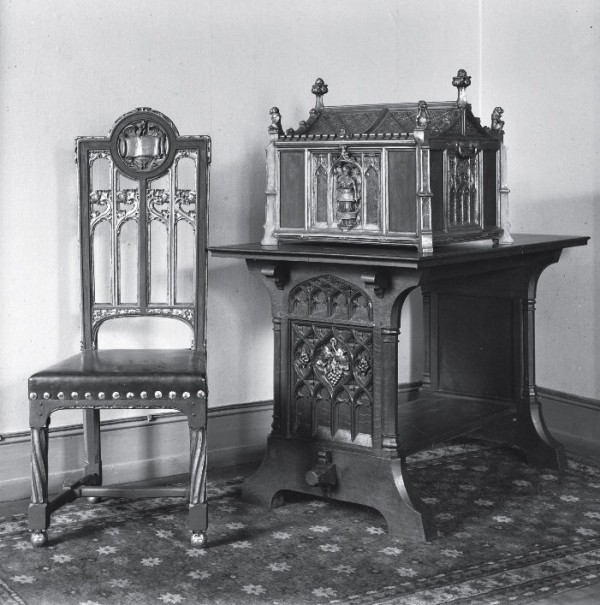
Chair, typewriter cover, and table designed by William Lightfoot Price and made in Edward Maene’s shop, 309 Griscom Street, Philadelphia, Pennsylvania, ca. 1906. (Courtesy, Athenaeum of Philadelphia.) These objects were made for the Mackay-Smith family.
